For this week’s post I am back in the Barbican, exploring Cripplegate with another of my father’s photos showing the area in 1947.
The church of St Giles provided a very clear landmark in last week’s photo, but when I first scanned the photo for this week’s post, there were no obvious landmarks or points of reference to help with identification.
I always look for any building that may still be there today. In the above photo, all the buildings in the foreground have been demolished, apart from one, which looks badly damaged and will also probably be demolished.
There is the paved surface of a street just above where my father was standing.
Many of the buildings in the background do appear damaged, although there are a couple that appear to have minimal if any damage, so could possibly remain today if they were not demolished for the Barbican development.
One building had a rather distinctive design, and also looked in good condition. I have marked this building in the photo below:
An enlargement from the original photo showing the distinctive features of this building:
After much checking on Google StreetView, followed up by walking the area, I found the same building. It now has a roof extension, but the external features are identical to those in the 1947 photo. This is the building of the old Cripplegate Institute on the corner of Cripplegate Street and Golden Lane.
I now needed to track down where my father was standing, and the location of the building in the cleared area. As ever, the Ordnance Survey maps held by the National Library of Scotland provided further evidence.
The following extract is from a post war Ordnance Survey map.
Credit: ‘Reproduced with the permission of the National Library of Scotland’
St Giles church is shown to the bottom right. The Cripplegate Institute is marked as a Library (it served multiple purposes which I will explain later in the post) towards the top of the map.
In the centre of the map, there is an empty area, with hashed lines for streets. This is the area demolished after the fires and bombing of the war.
There is one building still marked, a rectangle on what was Jewin Crescent, just above the ‘F’ of Fire Station. Could this be the large building in my father’s photo?
Between where my father was standing and the derelict building, there appears to be two streets. The first is easy to see, the second is a little distance back. This second street cannot be Jewin Crescent as it is not up against the derelict building. I therefore suspect that my father was standing at roughly the point marked where my red lines converge in the map extract.
This street, next to where my father was standing, was Edmund Place.
The alignment of the derelict building and the Cripplegate Institute / Library look right (centre arrow) and the arrows at the side show the approximate field of view in the 1947 photo.
I found some more evidence to confirm from the London Metropolitan Archive, Collage collection. In the following photo we can see the same derelict building that appears in my father’s photo, however now we can clearly see the crescent shaped street, and the location of the building at a street junction, exactly as shown in the map extract.
Image credit: London Metropolitan Archives, City of London: catalogue ref: M0020321CL
It is hard to imagine just how densely built these streets were prior to the destruction of 1940. My father’s photos show large areas of empty space, occupied only by cellars, low walls and the remains of paved streets.
Jewin Crescent was a relatively narrow street with tall buildings on either side. It was originally named simply “The Crescent”, but took on the name jewin Crescent in 1878.
The destruction of 1940 was not the first time that fire had damaged a large area of Cripplegate. On the 19th November 1897, another large fire destroyed much of Cripplegate. The following text is from the start of an article from the London Daily News on the 22nd November 1897 titled “The Terrible Fire – Acres of Ruins – Plans To Relief Sufferers – Four Thousand Persons Out Of Work – Narrow Escape of Firemen” which gives some idea of the scale of the fire:
“Yesterday crowds of persons from all parts of London visited the scene of the disastrous fire in the City to view all that remained of the warehouses and factories which were burned out on Friday. The police, who were again on duty in strong force, had the greatest difficulty in keeping the people back from the approaches to the ruined district, and all traffic in Aldersgate Street had to be suspended. It now appears that the thoroughfares affected more or less by the fire are seventeen in number, as follows: Hamsell-street, Well-street, Jewin-street, Jewin-crescent, Redcross-street, Monkwell-street, Edmund=place, Bradford-avenue, Australian-avenue, Nicholl-square, maidenhead-court, Fore-street, Paul’s Alley, Wood-street-square, Falcon-square, Hart-street and Peel-street.
It was on Saturday definitely discovered that the fire broke out at 15, Well-street, in the occupation of Messrs. Lewis and Company, ostrich feather dealers, and not at 30 and 31 Hamsell-street, as at first reported. This mistake is, however, explained by the fact that the rears of these two premises occupied by Messrs. Waller, Brown and Co., mantle manufacturers, and Messrs. Lewis, the former firm carrying on business in the top portions of the two houses. The fire, which it has now been ascertained was undoubtedly caused by an explosion of gas, broke through the premises of the firms in Hamsell-street, and it was in consequence of this that the flames spread with such rapidity along the two streets.
Of course, in some of the above mentioned street only a few of the houses have been touched but Jewin-crescent, Hamsell-street, Well-street, and the greater part of Jewin-street have been wholly destroyed.”
The City Press published a special supplement on the fire, showing the level of destruction across the street. One photo shows Jewin Crescent.
(reproduced from Grace’s Guide under Creative Commons Attribution ShareAlike Licence)
If you look in the above photo, there is a building on the right of the street that looks very similar to the building in my father’s 1947 photo, however counting the windows in the 1897 photo, it is not exactly the same, although it appears to be in the right position on Jewin Crescent.
I suspect that it was this building, but rebuilt and modified after the 1897 fire, as I did find a later view of the building, and it is identical to that in my father’s photo.
“Jewin Crescent, London EC1 (Art.IWM ART LD 1202)”
The above drawing is by Roland Vivian Pitchforth, one of his works for the War Artists Advisory Committee and is looking west along Jewin Crescent. At the end of the view, on the right of the street is a building that looks identical to that in my father’s 1947 photo.
Both the 1897 photo and wartime print provide a good impression of Jewin Crescent. A narrow, curving street, lined on both sides by tall shops, factories and warehouses. I suspect the building in the 1897 photo was modified or demolished after the fire, and a new building of similar style constructed on the same plot of land, but with changes to the floor layout and windows.
The area where Jewin Crescent and the 1947 building were located is so very different today.
I have marked on the following map extract the approximate locations of Jewin Crescent (red line), Jewin Street (blue line), and the building on Jewin Crescent seen in my father’s photo (orange rectangle), in what are now Thomas More Gardens. The Cripplegate Institute is the orangae circle (© OpenStreetMap contributors).
The following photo shows Thomas More Gardens today. The left part of the 1947 building would have been in the middle of the photo, leading off to the right.
The same location could hardly be more different. Instead of a densely built, narrow street, which must have been busy with workers and the movement of goods on a work day, Jewin Crescent is now covered by grass, and is a peaceful place surrounded by the buildings of the Barbican estate.
As an aside, a lower level view from around the gardens, provides some interesting perspectives of the Barbican’s architecture. In the following photo, it is clear to see how Gilbert House traverses the lake, held high above the water by a series of (at this distance) surprisingly slender pillars.
Returning to the building that initially helped me to identify the location, the Cripplegate Institute building is hard to photograph from the south as there is a raised walkway and buildings of the Barbican estate which obscure a full view of the south facing side.
The main part of the building faces onto Golden Lane. The following photo shows the part visible in the 1947 photo, with the main facade on the right.
The Cripplegate Institute provided a of range educational and cultural services to the residents and workers of the area. A good description of the scope of services offered by the institute, and the very high level of usage of these services is well described in an article from the Shoreditch Observer, dated the 7th November 1908:
“CRIPPLEGATE INSTITUTE – Cripplegate demonstrated its warm interest in its foundation institute on Wednesday night by attending the 12th anniversary conversaxione in strong force. Close upon 400 guests accepted invitations, and they were received in the handsome gold-and-white theatre hall by Mr. B.T. Swinstead, the chairman of the Governors and a member of the Corporation, many of whose members greatly assist the work. The prizes won in the various classes were presented by Deputy and Sheriff Baddeley, and the chairman, in referring to the work of the Institute, said that in the lending part of the library, in which there were 52,000 volumes, some 1,500 books were issued daily, while the average attendance in the newsroom was 5,000 per day.
A special feature was made of the St. John Ambulance and Nursing classes for men and women, and it was hoped to make the Institute the centre for first aid and nursing work in the City. The penny dinner-hour concerts had been attended by 13,284 persons during the year, and over forty societies and clubs had their headquarters in the building. An excellent musical and dramatic entertainment followed.
Owing to the tremendous pressure on the various departments of the Institute, the governors are considering the question of adding another storey to the building, to accommodate the physical drill and other sections of the educational and recreative work.”
The last paragraph explains how the building came to look as it does today. The original building was smaller and of plainer design. The majority of the features we see on the building today, are from the addition of an extra storey.
Some of the figures quoted in the article are remarkable – 1,500 books issued daily, and 5,000 people using the newsroom a day. The institute must have provided much needed services for those living and working in the area.
The Cripplegate Institute opened in 1896, however the foundation stone was laid by the Duke of York two years earlier in 1894:
The laying of the foundation stone was a typically ceremonial event, with an honour guard from the Honourable Artillery Company, and a band from the same regiment providing the music.
The speeches included very clear references to why such an institution was needed and to the literary importance of Cripplegate:
“The great increase in English literature which had taken place during recent years rendered it most necessary that every effort should be made to place some of that knowledge within the reach of those who were unable to provide themselves with books, either for recreation or instruction, and it was a very natural feeling that the ward of Cripplegate, where Milton and Defoe and other noted authors lived and worked should endeavour to place our literature at the disposal of even the very poorest of our fellow citizens by means of free libraries such as that institute could afford.”
The Duke of York was presented with an inscribed trowel – given the amount of foundation stones laid over the years, I imagine that in some Royal collection somewhere, there must be thousands of trowels, collected from a couple of centuries of foundation stone ceremonies.
The Cripplegate Institute was largely funded by the Cripplegate Foundation, a charity formed in 1891 by the London Parochial Charities Act based on the charitable assets of St. Giles Without Cripplegate, with original gifts dating back to 1500.
The Cripplegate Institute closed in 1973, and the building reopened soon after as the Golden Lane Theatre. The theatre presented a number of professional productions, but was also a focal point for amateur, educational, theatre and dance groups to put on productions.
The Golden Lane Theatre closed around 1988 and the interior has since been converted into office space, and is currently occupied by the Swiss bank UBS.
I suspect it disappeared during the office conversations, but the facilities of the Cripplegate Institute included a rifle range, and in 1940, when the possibility of a German invasion seemed very real, workers were encouraged to sign up for rifle training. 400 workers from the City of London trained at the Cripplegate Institute. Hopefully for the photographer, their guns were not loaded.
View of the old Cripplegate Institute building from slightly further along Golden Lane, at the junction with Brackley Street.
When I first scanned the 1947 photo, I was really not sure that I would be able to track down the location, but starting with the Cripplegate Institute I now know the buildings and street in the photo and roughly where my father was standing when he took the photo.
The development of the Barbican means that it is impossible to take a view of the same scene today, but it is brilliant when walking around the Barbican Estate to think about what was here before, and the fascinating history of this area.

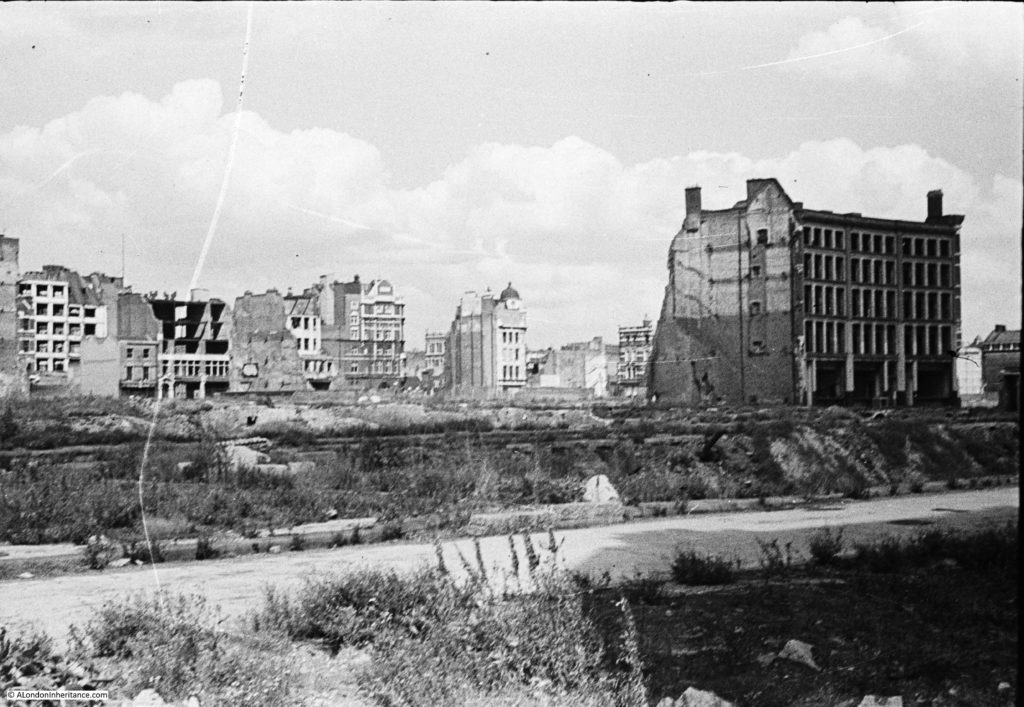


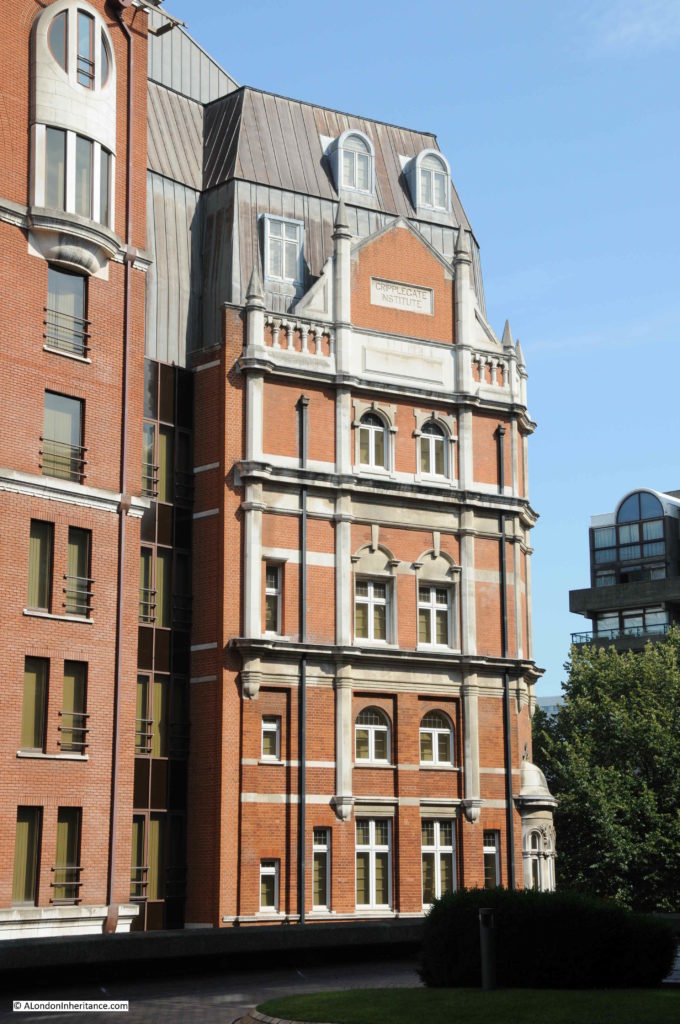
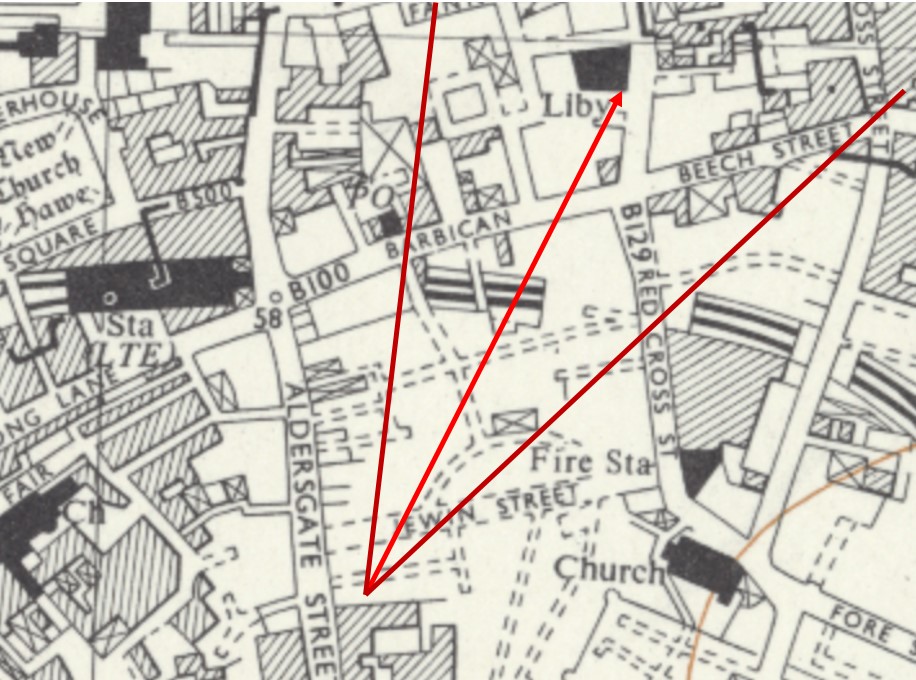
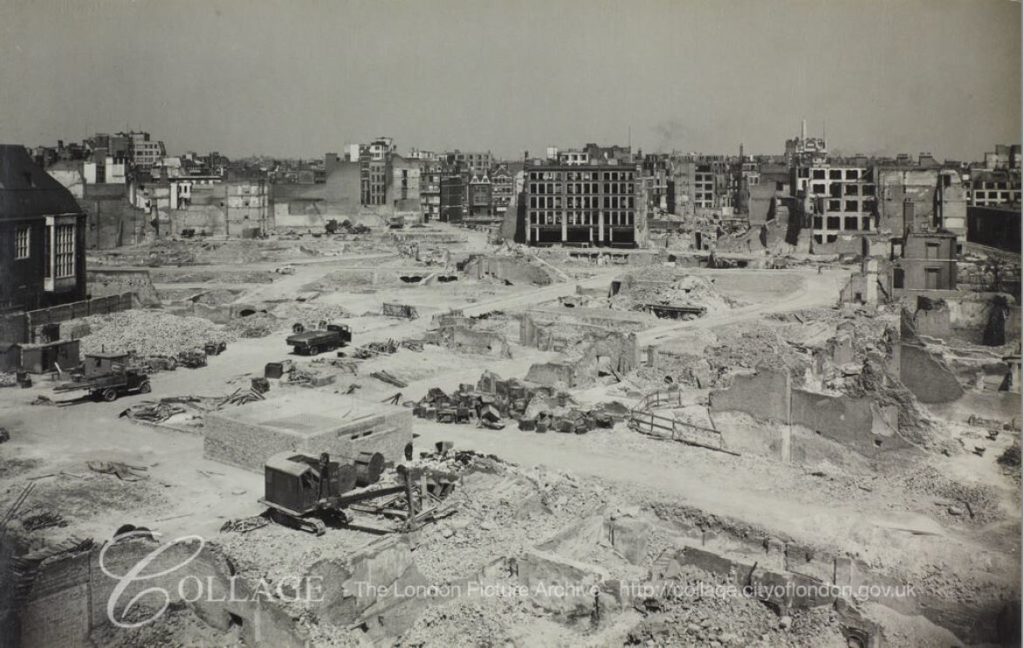
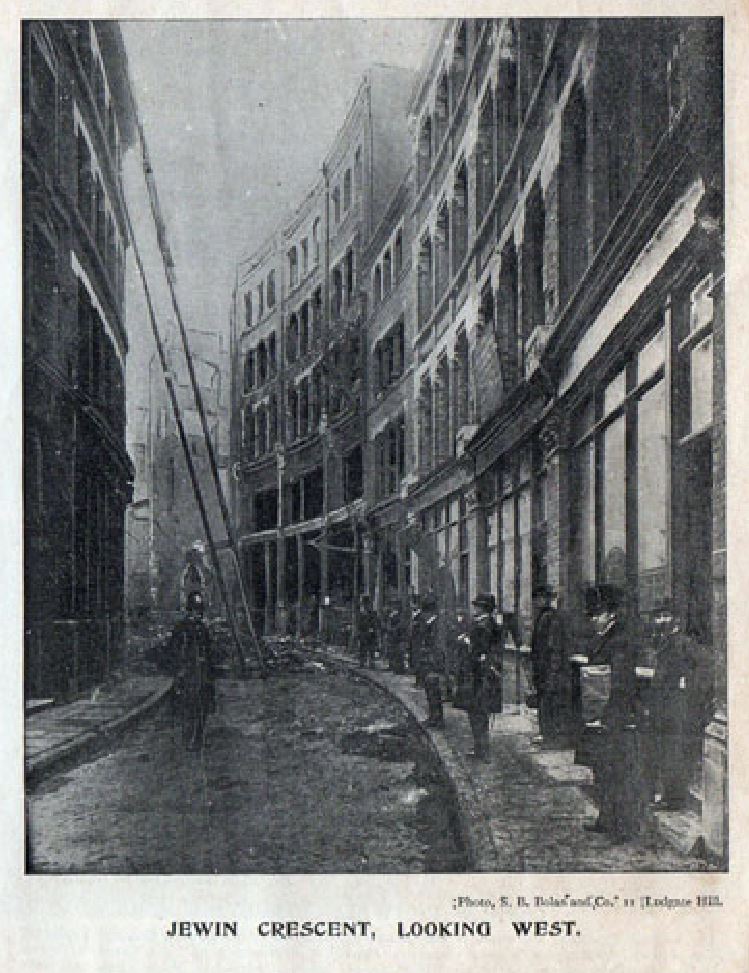
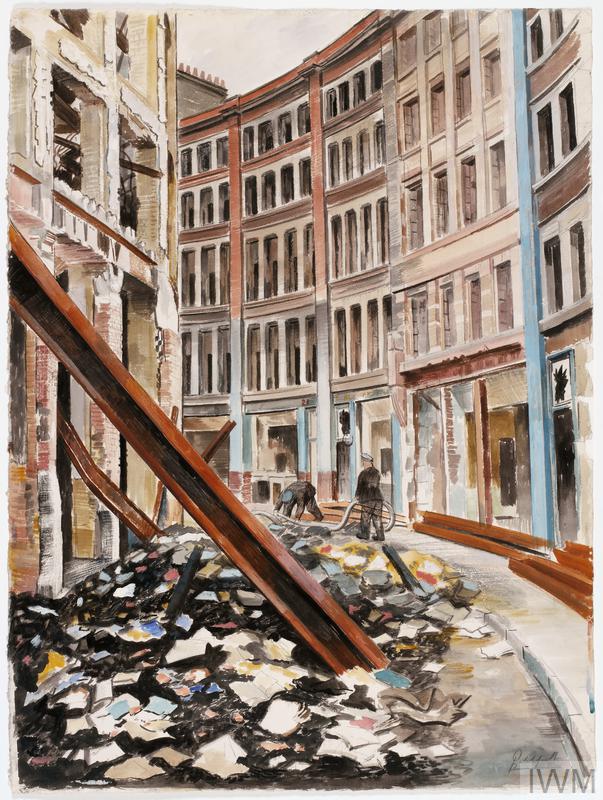
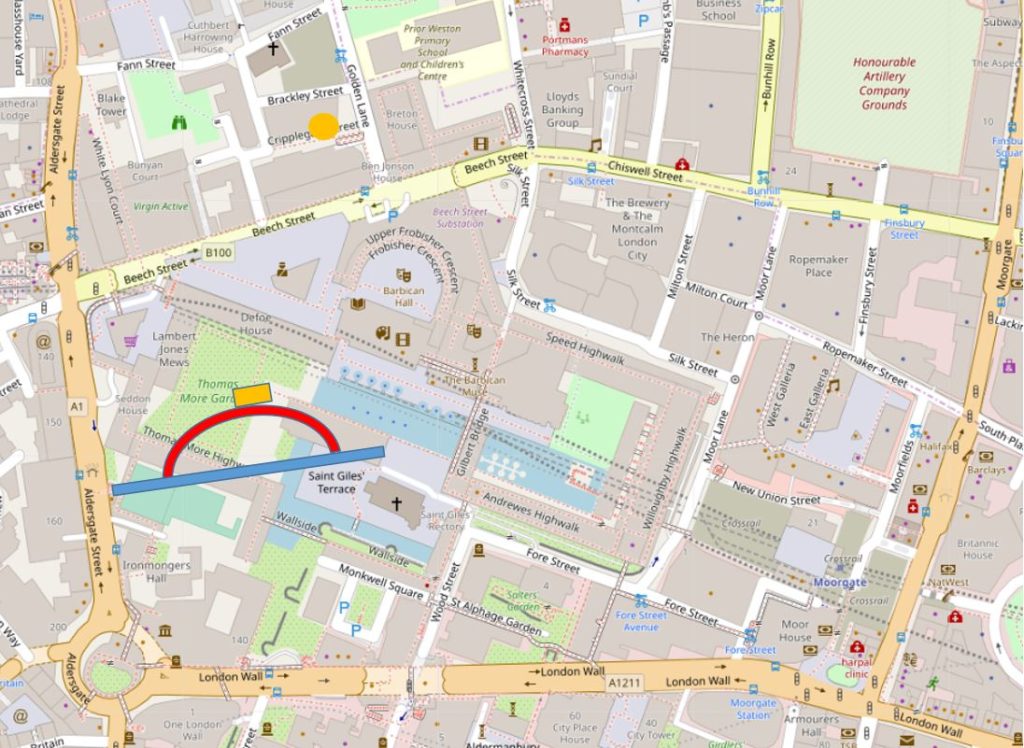

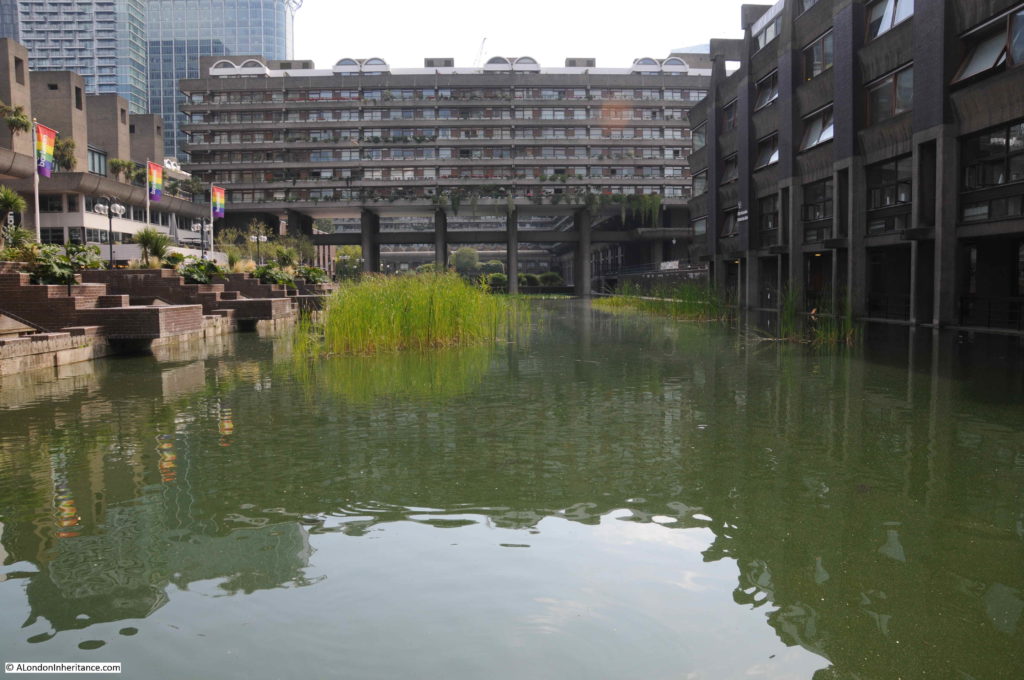


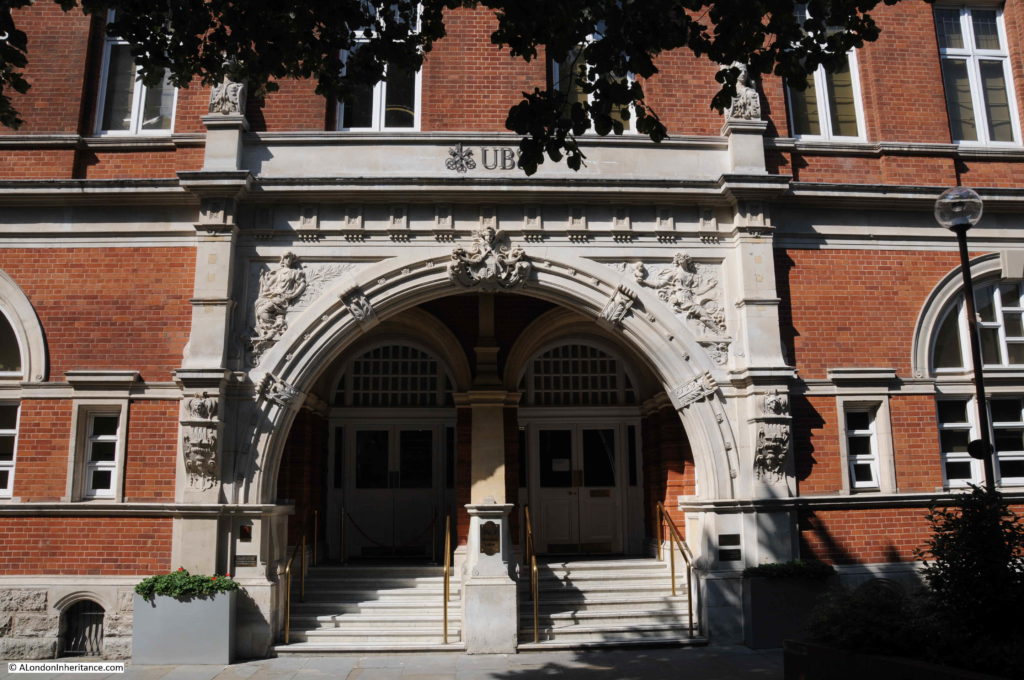
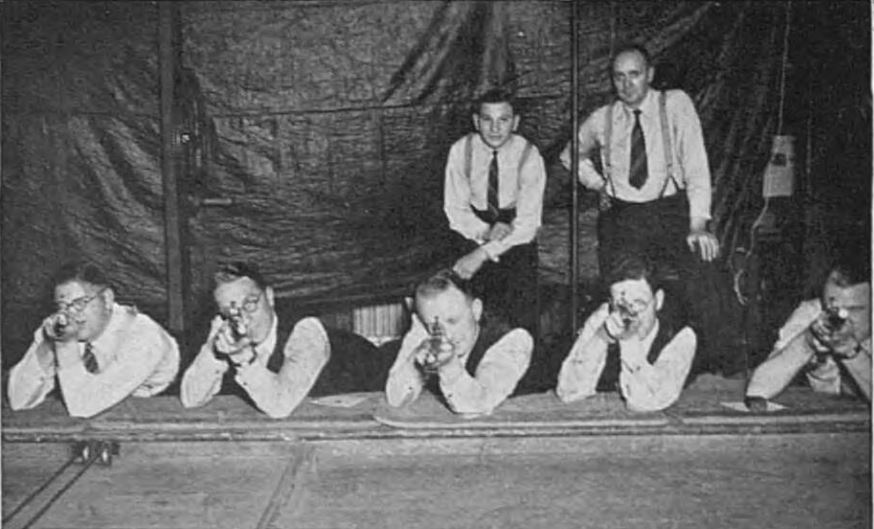
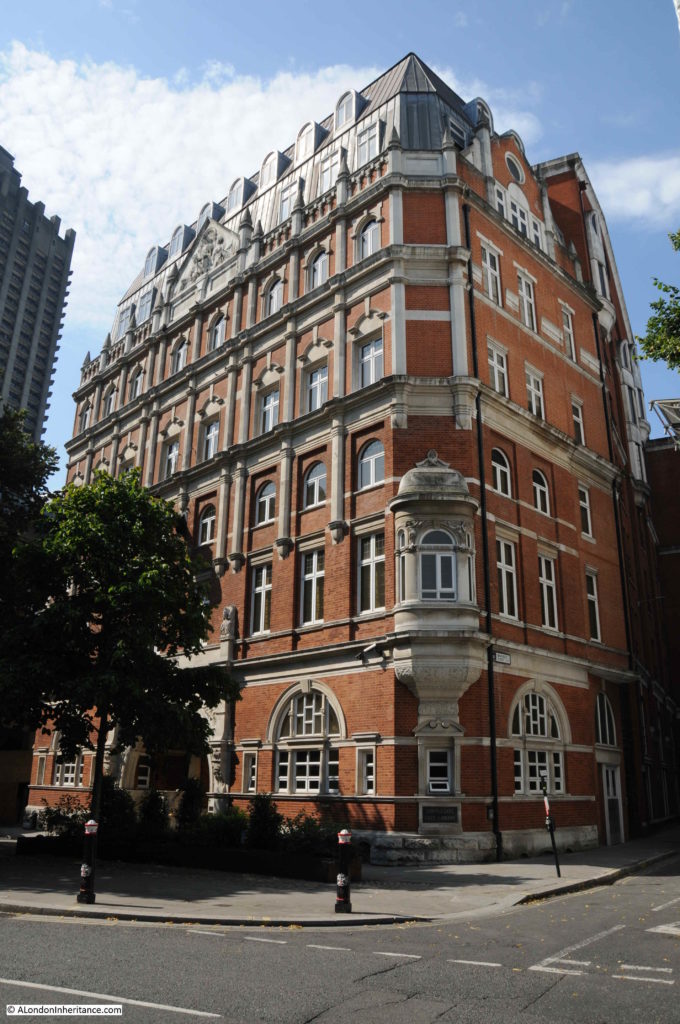
Thankyou very much for really interesting blogs, power to your elbow. Good Look from George.
Absolutely fascinating, as always.
My family were vintners in Jewin Crescent in the 19th century. My great grandfather and mother lived there and eventually ended up in the Sutton Arms in Carthusian Street nearby that survived the Blitz.
Really interesting blog today especially as I overlook the spot where your father was standing when he took the photo. I went to the exhibition at St Giles yesterday and was interested in Cripplegate Tales. I omitted to obtain details and now cannot find it on the internet. Are you able to help with this.
Ann, the Cripplegate Tales website is here https://talesofcripplegate.com/
Thank you very much. Very helpful
i went to school here arts ed 1972 real theatre oh so many stories xxx
–
David
Great to be able to meet you yesterday at St Giles and to thank you for your blog. I’ll now have to go back there to see the places in this piece of detective work.
Thanks again.
Richard Shepley
My daughter forwards your posts each week. I find them most interesting. We then exchange comments about the post, which is something I look forward to doing with my daughter. Another dimension in our relationship since the posts and our comments have taken us in so many directions.
Maybe not something you had thought of in starting your posts, but a very positive outcome. Thank you Wayne Lamon
Another excellent article, thank you. So sorry that I was unable to make the Barbican and meet with you. That building in Jewin Crescent appears in two films on our Website – The Weapon (1956) and The Key Man (1957). It appears in another film that I am ‘re-visiting’, “It Happened Here” that will be going live shortly.
What an absolutely beautiful building. It is good to see it still standing and well cared for.
If only today’s buildings were similar !
As ever, an excellent piece of detective work and an interesting read. Thank you, David.
The Cripplegate/Golden Lane theatre was in operation in the late 1960s for amateur groups. I took part in a production there of Princess Ida (Gilbert & Sullivan) in autumn 1968 or spring 1969. The title role was taken by (later Dame) Felicity Lott; this was one of her first stage appearances.
The Cripplegate theatre operated from at least the 1920s and was the home for quite a while of the venerable Ingoldsby Club , regarded as London’s, and possibly the UK’s, oldest amateur theatre company
Good evening!
Another fascinating story. I look forward to your Sunday History lessons!
Apologies for not attending yesterday,prior engagement.
Keep up the good work.
Thanks again for your wonderful stories of old and new London.
Seeing your father`s photos reminds us of how much destruction happened in WW2. The generation that remembers that is sadly almost gone now.
I appreciate the opportunity to have history told as a story that is meaningful.
As someone who left London many years ago it is fascinating to follow from afar.
Hello David
Was good to meet you on Saturday at St Giles, and thanks once again for my regular Sunday morning read. If you want to know more about the Islington tour guides course then search for CIGA or Islington Guided Walks on whose site you will find a link to the university’s application form. Or get in touch with me!
Outstanding bit of historical research
Thank you
Fascinating, as ever. This part of London is so totally changed and I don’t imagine there are many people still alive who recall it pre-war. I wouldn’t mind a time machine just so I could go back and walk down Fore Street before popping into St Giles, then take a stroll up Silver Street and a pint in the pub on the site of Shakespeare’s rented home. On the other hand, I wouldn’t mind a flat in the Barbican, either…
There is a film on the BBC ‘catch up’ of John Betjeman standing amongst the ruins of what is now the Barbican development. The films ‘The Key Man and The Weapon have been on Talking Pictures (ch 81) but there are stills on the Reelstreets website:
https://www.reelstreets.com/films/key-man-the-aka-life-at-stake/
https://www.reelstreets.com/films/weapon-the/
Yes Jean!! Absolutely right. Mr Butland was my mum’s employer at the Cripplegate. We lived in Fortune House on the corner of Golden Lane and Fortune Street. In 1965 your dad agreed that I could go over with my mum to practise the piano as we didn’t have one at home. The piano became my passion and I eventually made a career out of music making. Strange to think that the Cripplegate piano was to thank for that. Our mum, Anne Hogg, died in 2015 aged 90 and is buried in St Giles without Cripplegate alongside our dad Wally. Janet and I now both live in Worthing
I lived opposite the cripplegate institute until I moved away in 1979. My mum was a cleaner there and would polish the brass handrails until you could see your face in them. In the sixties there was a beautiful library and theatre there, as well as a secretarial college. I first started my piano practise in that building! Very fond memories. Police section house next door.
Richard, I lived in Cripplegate Institute from October 1962 until the early 70’s as my Dad Les Butland was the Caretaker there. Wonderful days growing up in that fabulous building. What was your Mum’s name? I remember a lady called Anne who worked there and she had a daughter named Janet. I went to the Secretarial College as well. Best Wishes Jean Sheppard formerly Butland.
I am a local resident who found this blog very interesting. I believe that the Cripplegate Institute lives on today in a slightly different form of a charity (covering LB Islington and part of The City of London) .
I was speaking to someone at St Luke’s Community Centre (part of St Luke’s Parochial Trust) just up the road on Central Street who told me that for a time Cripplegate (as a charity) relocated their offices to a shared space at St Luke’s.
St Luke’s Parochial Trust, as a community facility is also closely connected with the historical parish and still shares a connection to St Giles without Indeed there is a permanent position on their Board from a member of The church of St Giles Without.
Both prior to and after the closure of St Luke’s (the church) the surrounding area has been part of the Parish of St Giles Without Cripplegate and today extends to the boundary of Lever Street.
My understanding is the Parish of St Luke’s and that of St Giles Without Cripplegate have interchanged many times and have a complicated history.
As a child I attended the ARTS EDUCATIONAL SCHOOLS at this location …the info is really moving and THANK YOU for bringing back childhood memories within the space….that was around 1978 – 81 I was there…
I attended Cripplegate college in 1967 when it was a secretarial college and I remember the theatre well. We did several productions there. The Barbican had just started being built but work stopped due to a strike ! Very happy memories. I visited the building in 2008 and, of course, it was the Swiss bank by then. Thank you for the blog, most interesting
I have consulted the relevant page of the Goad Insurance Map (1886), which is available online via Collage, record no. 34663.
The building which used to occupy the NE corner at the junction of Australian Avenue and Jewin Crescent was no. 17. My guess is therefore that the Jewin Crescent ruin occupied nos. 19-23.
Anthony camp has written an amazing book about Fann st
It is a very good read I’m full of history concern in the area
I came across this website quite by chance whilst trying to find information about a hotel called The Welcome which used to be at 6 Jewin Street. The grandmother of a gentleman who contacted me used to work there but so far no luck.
Regarding Cripplegate Institute, I used to know the building quite well. I was Secretary to the Clerk to the Governors of Crpplegate Foundation (Mr. John Williams) which owned the Institute. The Foundation was an amalgamation of the charities based on St. Giles Church, the earlliest recorded gift being by John Sworder in 1500. Cripplegate Ward, like many others in the City, changed greatly in the late 19th and early 20th centuries becoming more a place of work rather than residence and many of the gifts were no longer in use i.e. 6 loaves of bread to 6 poor widows at Easter! All the gifts were, as mentioned above, amalgamated into the Cripplegate Foundation whose remit was to assist individuals and organisations who lived or worked within the Cripplegate ward.
The Institute, as such, ceased to function in the 1950’s as the state took over teaching facilities and libraries. A Pitmans Secretarial College was based there before moving to Wilson Street and the building was taken over by The Arts Educational School in 1970. It was then subsequently sold.
The library, consisting of 32,000 books, was the basis for the Barbican Library.
The Cripplegate area was so badly ruined because the bombs dropped were incendiary and didn’t just destoy buildings but set fire to everything as well. A Foundation Governor, who worked in the area at the time, told me that posts were put in the ground with the name of the company that used to occupy that space tied to them on pieces of paper. All the employees were told to gather by ‘their’ post so they could be accounted for and she said it was very errie because all you could hear were the pieces of paper rustling in the wind and no other sound.
The only buildings left standing after the devasation were the church (very badly damaged with no roof), the police section house and the Institute.
When the Institute had been sold I believe the outside was listed and also the internal staircase which is why it has survived but the inside was modernised. On reading through old minute books it appeared that a time capsule of some kind had been buried behind the foundation stone when it was laid so we contacted the developers and told them to be careful in that area. They were very good and quite as intrigued as we were so when they got near to it the Foundation were advised and we all went to the site. It was found and, if I remember correctly, consisted of a large glass jar with money of that time, a newspaper, a copy of the opening ceremony programme etc., were found. We made up another time capsule (I can’t remember exactly what was in it) and they were both re-buried behind the stone.
The Foundation’s offices used to be on Worship Street in a building that it owned but subsequently moved into a new building next door to St. Luke’s on Central Street. St. Luke’s (always looked upon as our ‘sister’ charity) was a Day Centre for the Elderly with lunches and jollifications. They took about 150 pensioners away on holiday every year and there was always a Christmas pantomime. The conference centre where these pantomimes took place and the Founcation’s offices have now been demolished and the latter has moved into Islington.
The closure of St. Luke’s Church on Old Sttreet is rather amusing. The then Rector, Edward Rogers, was taking a service some time in the 1950’s; I think it was an important time such as Christmas. He looked up and could see daylight between one wall and the tower. A building inspector was called and he immediately closed the church and condemned it. The roof was removed and it fell into ruin. Apparnetly the ground in that area was very boggy and it had been built on a sort of raft consisting of tree logs. Needless to say they rotted over the years and the foundations began to move – a bit like Venice really! Various ideas were put forward for its use and it eventually became a teaching centre for the LSO.
I was interested to read about Les Butland. I met him a couple of times and John Williams knew him and his wife quite well as he was caretaker whilst John was there.
I am sorry to have rambled on and most of it is from memory as I retired from the Foundation in 2001 and no longer have access to files to check my facts but I hope it hs been of interest. Incidentally the plinth at the top of the steps at the main entrance to the Institute used to carry a statue of a lady holding a lamp above her head. I don’t remember what she signified but probably ‘education’ or something of that sort. I never could find out what happened to her.
Regards,
Barbara Allan
Hello Barbara
I am Les and Ena Butland’s daughter Jean. We moved to Cripplegate from Portsmouth in 1962 when I was 10. It certainly was a mess around that area. I remember the Fire Station near St Giles Church and there was Bank on the corner. I think, opposite Cripplegate, was the Coroner’s Court. I loved living at Cripplegate. Used to watch the productions in the Theatre and I eventually attended the Secretarial College. Mrs Bradley was our teacher. I remember also Mr Hoy in the general office and the office girls, Jasmine, Pam and Judith, not sure if you would have known them. Lovely memories.
Best wishes Jean Sheppard
Dear Jean,
Thank you for replying to my comments. I am not very good at computers so I am surprised this has worked!
They were indeed lovely days. I remember Tom Hoy who I met a couple of times but when I joined the Foundation it was 1983 just after all the changes had taken place. The offices on Worship Street were very nice and we had a caretaker called Jack who I believe your father would have known and a cleaner called Edna who also used to prepare our lunch (soup and salad every day with wine from the cellar on Friday!). She worked at the Institute in the restaurant/canteen?
When the Institute building was being sold and we realised that the inside was going to be completely revamped, John Williams, another lady from the office and I spent a day removing the brass handles and hand plates from the doors and also some lovely plate glass signs so that they could be kept in the Foundation’s archives and not destroyed. We left it all in boxes in the Institute overnight to collect the next day but that night thieves broke in and stole everything. So sad.
I hope you and all your family are keeping well.
Regards,
Barbara
i went to school here arts ed 1972 real theatre oh so many stories xxx
–
First, I have looked at your site before with great pleasure and admiration.
On this occasion I was searching for Jewins Crescent having come across it while researching family history.
The name appears in the register of marriages at St Giles Cripplegate on 25 September 1854. It therefore appears that the name was in use before 1878.
it would seem things get reset and this was another reset a cull just like the 1666 shenanigans
what and who was montague norman what and who else was involved with the b i s bank swiss
war is always a bank racket
I couldn’t help noticing your name is CHARLES DRAKE.
Does anyone else remember Charlie Drake making a film in Whitecross Street in the sixties called The Locksmith? If you get a chance try and find a copy. Fascinating!
Like a few others, I came across your site quite by chance, while researching the ‘life and times’ of ancestors who lived, variously, in Jewin Crescent, Cowcross Street and Sharp’s Alley, in the mid-19th Century.
So, this is just a big thank you for your efforts. From your site [and one or two others] I now know a bit more about when buildings [their homes!] disappeared.